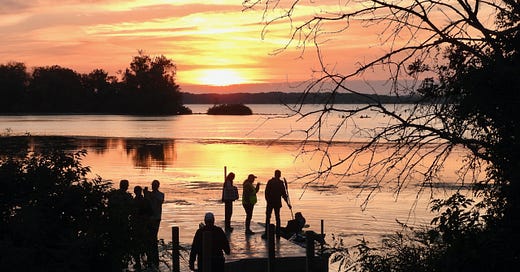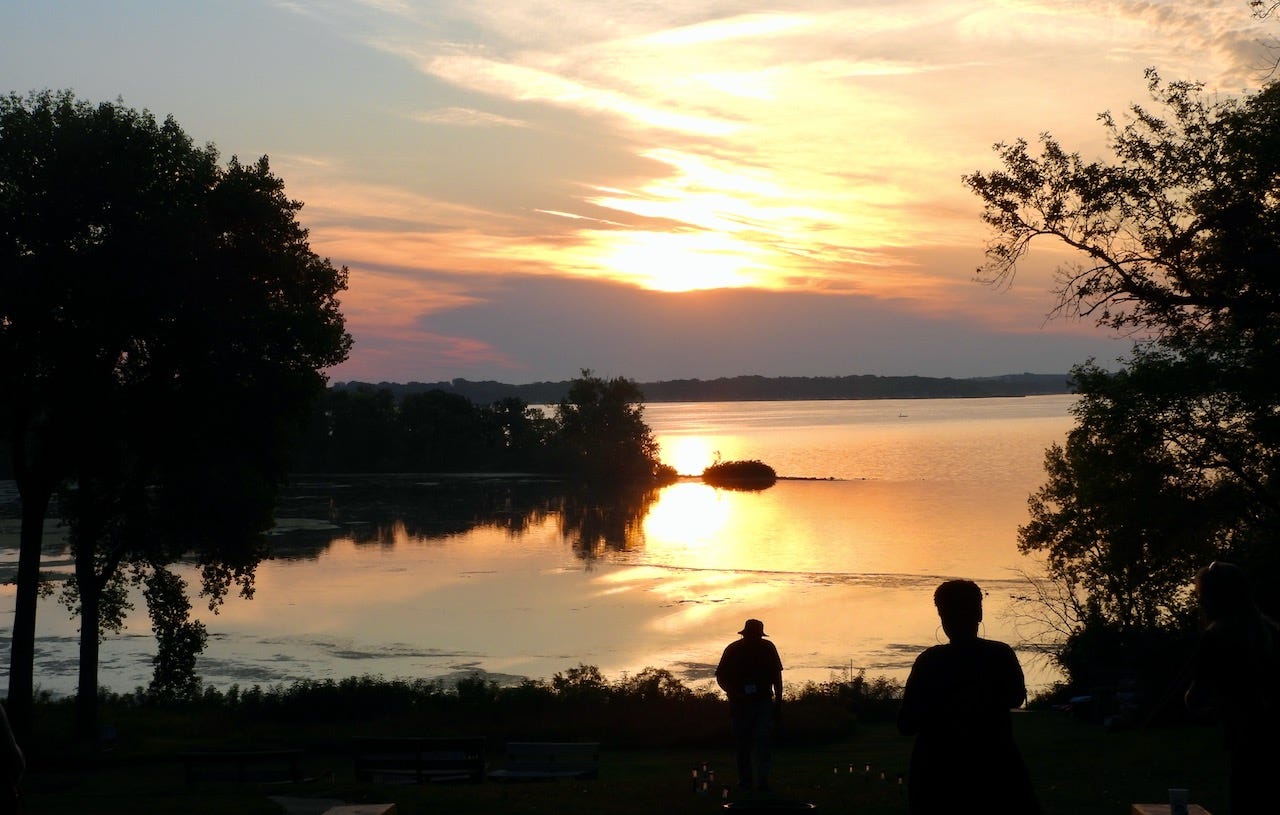The slap-slap of waves lapping at kayaks; drip-dripping of water off the paddles; the almost imperceptible whispers of the breeze tickling the shoreline cottonwood leaves: Who knew a lake could speak?
Iowa native Aldo Leopold, author of the conservation classic, “A Sand County Almanac,” called such sounds “numenons.” Leopold was keenly aware of sounds as “something that carries the immeasurable yet still perceptible spirit of a place.
At West Okoboji Lake, participants in the recent Okoboji Writers’ Retreat at Iowa Lakeside Lab immersed themselves in that “soundscape,” as they “listened” with all their senses. On a rocky spit, ring-billed and Franklin’s gulls loafed in the sun, occasionally flapping skyward with a chorus of shrill laughs and mews before settling back down to shake and preen and splash.
Just under the surface but rooted to the bottom, Sago pondweed and coontail waltzed from the emerald depths. A froth of bubbly algae topped the submergent vegetation like dollops of lemon-lime whipped cream.
Slender damselflies flitted amongst the canoes and kayaks, as content to rest on a boat as on a glob of algae. Occasional turkey vultures hung on thermals over the bay, perhaps using their keen sense of smell to locate a meal of dead fish or frog or raccoon.
An adult bald eagle perched – seemingly with gratitude – near their nest above a “Quiet Please: Eagles Nesting” sign. Was that the same bird that previously had circled the bay, ironically screeching and cackling at the paddlers.
Mary Skopec, director of the Iowa Lakeside Laboratory, sat in her kayak, surrounded by other boaters, as she lauded Okoboji area residents and landowners for efforts to enhance the lake’s water quality. Clarity has doubled in the past 25 years, she said, and phosphorus levels have decreased dramatically. The Okoboji Protective Association and other private and public groups have restored wetlands and prairies in the watershed, protecting the lake from agricultural runoff.
Other environmental threats could prove more difficult to control, Skopec acknowledged. Zebra mussels, small Eurasian mollusks that apparently came to North America in ballast water of large ships, were found in West Okoboji in 2015. The mussels are prolific filter-feeders, sometimes depleting algae that native mussels feed on.
Eurasian water milfoil, an aquatic plant that can grow six inches in one day, was found in East Okoboji Lake and other nearby lakes in 2022. The weed can crowd out other vegetation and make boating nearly impossible. Iowa DNR officials have used herbicide to attempt to control its further spread.
Human conflicts also have threatened Okoboji and the Iowa Great Lakes area since the so-called Spirit Lake Massacre of 1857. Renegade Santee Sioux leader Inkpaduta killed 35-40 northwest Iowa settlers to avenge the murder of Inkpaduta’s brother and his family by white intruder Henry Lott, who also was a horse thief.
The lake has lured wealthy homeowners and vacationers for more than a century. Some lakeside lots now reportedly sell for $20,000 per shoreline foot, and feature multi-million-dollar homes.

Recreationists pack West Okoboji during the summer tourist season. Huge power boats, personal watercraft, and water skiers compete for space. Although the fishing can be excellent, most anglers choose to wet a line early in the day or at night, when other boat traffic is lighter.
Miller’s Bay, a large but sheltered bay near the Lakeside campus, sometimes is referred to as “Party Cove,” because revelers often gather on large boats to drink and play loud music all day.
Iowa Lakeside Laboratory remains a natural jewel in the thorny crown of human development encircling West Okoboji. Credit goes to visionary Iowa naturalist Thomas H. Macbride, who also was president of the University of Iowa. He founded Lakeside Lab in 1909 “to enable students and teachers to learn about nature in the field.” Macbride chose the site on Little Miller’s Bay for its surroundings of natural lakes, wetlands, tallgrass prairie, shortgrass prairie, and savannas, as well as prominent geological and glacial features. Geologist Samuel Calvin and fellow naturalist Bohumil Shimek also were instrumental in acquiring the first six-acre parcel, and a residence that still is in use as part of the campus. Lakeside Lab has grown to 147 acres, with housing, research stations, and educational and community facilities available year-round.
Skopec said Lakeside is in the midst of a capital campaign to raise $14 million to expand and replace the botany lab to have more space for classrooms and water quality testing, and to replace aging motel unit housing. Private donations will supplement hoped-for legislative appropriations and foundation grants. To donate, visit Friends of Lakeside Lab
Yes, West Okoboji “speaks” in many ways. But so can other favorite landscapes if we follow Aldo Leopold’s advice to listen, look, and feel for “something that carries the immeasurable yet still perceptible spirit of a place.
Thanks to the Iowa Writers’ Collaborative for reconnecting me with several old friends from my 25 years as outdoor water/photographer with the Des Moines Register from 1972 to 1997. Plus the group has helped me discover the talents and insights of a new (to me) set of writers. I enjoy sharing my Iowa roots, memories, observations, frustrations, and joys with those folks - and with readers.
I’m an Iowa farm kid who has never outgrown playing in the “crick.” Every kid should have that same opportunity to go outside and get muddy. And I can easily wax nostalgic about the wild places we have lost in my seven-plus decades on this planet. For more about where those times, people, and adventures have led me, here’s a link to my website.
Listening to the Land is a reader-supported publication. To receive new posts and support my work, consider becoming a free or paid subscriber.
To see commentary by some of Iowa’s best writers, please follow the Iowa Writers’ Collaborative members:












